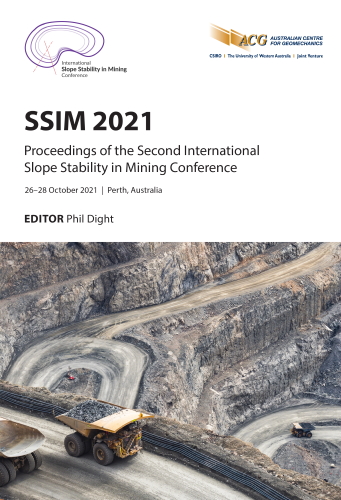Optimisation of slope design using three-dimensional limit equilibrium: case studies from the Pilbara

|
Authors: Dwumfour, D; Jele, R; Jolly, Z |
DOI https://doi.org/10.36487/ACG_repo/2135_03
Cite As:
Dwumfour, D, Jele, R & Jolly, Z 2021, 'Optimisation of slope design using three-dimensional limit equilibrium: case studies from the Pilbara', in PM Dight (ed.), SSIM 2021: Second International Slope Stability in Mining, Australian Centre for Geomechanics, Perth, pp. 95-104, https://doi.org/10.36487/ACG_repo/2135_03
Abstract:
Slope design assessments for rock mass failure modes are typically undertaken utilising two-dimensional limit equilibrium (LE) software packages. What happens in scenarios where the design has adopted the recommended slope configuration and still the inter-ramp and overall slope do not meet the design acceptance criteria? This paper presents two case studies within the Pilbara where a three-dimensional LE approach was implemented to further assess slopes that fail to meet the adopted design acceptance criteria, providing an optimal final slope design for implementation.
Keywords: geotechnical, slope stability analysis
References:
Read, J & Stacey, P 2009, Guidelines for Open Pit Slope Design, CSIRO Publishing, Collingwood
Roscience Inc. 2019, Slide 2, version 2018 8.027, computer software, https://www.rocscience.com/software/slide2
Bentley 2021, Plaxis 3D LE, version 21.02.00.170, computer software, https://www.bentley.com/en/products/product-line/geotechnical-engineering-software/plaxis-le
Bentley 2019, Soilvison, version 10000013, computer software.
Snowden 2011, Snowden Modified Anisotropic Linear Strength Model, unpublished memorandum to Rocscience.
Snowden 2007, Proposal for Additional Features in SLIDE and SWEDGE, unpublished memorandum to Rocscience.
© Copyright 2025, Australian Centre for Geomechanics (ACG), The University of Western Australia. All rights reserved.
View copyright/legal information
Please direct any queries or error reports to repository-acg@uwa.edu.au
View copyright/legal information
Please direct any queries or error reports to repository-acg@uwa.edu.au